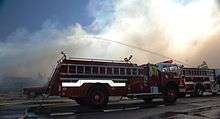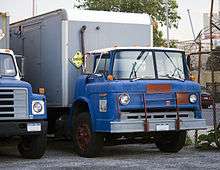Ford C-Series
| Ford C-Series | |
|---|---|
|
| |
| Overview | |
| Manufacturer | Ford |
| Also called | Mercury M-Series (Canada) |
| Production | 1957-1990 |
| Assembly | Kentucky Truck Assembly, Louisville, Kentucky |
| Body and chassis | |
| Class | Medium-duty truck |
| Body style | Cab over |
| Related |
|
| Powertrain | |
| Engine |
Gasoline Diesel |
| Transmission |
Manual Automatic |
| Chronology | |
| Predecessor | Ford C-Series (F-Series COE) |
| Successor | Ford Cargo |
The Ford C-Series is a medium-duty cab-over engine (COE) truck that was built by Ford between 1957 and 1990. It was used primarily for local delivery, and fire apparatus. Many of the fire trucks came merely as cab and windshield models.
In production nearly unchanged for 33 years, the C-Series was the longest-produced commercial truck in North America at the time it was discontinued. Only the Mack Model R (39 years) and Kenworth W900 (55 years; still in production) have remained in production longer.
C-Series COE (1948-1956)

Like other automotive manufacturers that built COE trucks before the 1960s, early Ford C-Series trucks were "helmet-shaped", cab-forward trucks that shared components with pickup trucks (the F-Series, in this case). From 1948-52, they were simply COE versions of the F-5, F-6, F-7, and F-8. For 1953, they were redesignated the C-Series, but largely remained modified F-Series trucks.
Models consisted of the C-500, C-600, C-700, C-750, C-800, C-850 and C-900. Like the F-900, the C-900 also included a "Big Job" model. Diesel-engined trucks included an extra zero in the model designations (i.e. C-8000 or C-9000).
Design history

As Ford started squaring off its vehicles in 1957, they finally gave the cab-overs their own designs separate from the rest of the Ford truck lineup. It featured a small grille near the front bumper, with a four-pointed star emblem on each end, the word "F O R D" spelled out below the windshield, and had a cog-and-lightning bolt crest emblem between the headlights. Variations of this emblem were found on many other Ford trucks during the 1950s and into the 1960s. The C-Series held onto this logo the longest.
Design updates
In a fashion similar to the Checker Marathon or Volkswagen Beetle, changes to the C-Series trucks throughout its production were very subtle. If anywhere, many of these changes were identifiable by the changes in the cowl insignias and badging. Between 1958 and 1960, the C-Series used a quad-headlight fascia. This was helpful for fire departments, which wanted to use the extra headlight bezels for emergency flashers, an option that was offered exclusively to fire, and other emergency vehicles after 1960.[1] In 1961, Ford reverted to the single headlight design; the regular C-series cab closely resembled the 1957 version.[2] A new Super Duty model was added. Another option included a small sleeper cab.
1963-1990
For 1963, the C-Series was updated with the same cowl insignias used by the rest of the medium- and heavy-duty truck line up. The logo had the word FORD on top of a trapezoid with the model number designation. This insignia was used until 1967.[3][4] Also in 1963, Ford introduced diesel versions of the C-series, as well as the N-series and Heavy-Duty F-Series.[5]

In 1968, federal regulations required all automotive manufacturers to add side marker reflectors or lights, which Ford was able to add to the new cowl insignia used on the F-Series since 1967. That same year, Ford decided to add this insignia on the doors of the C-Series, as well. Unlike the Ford F-Series, which removed them for 1973, the C-Series would retain them until the end of production in 1990. After 1972, the Canadian Mercury version of the C-Series was discontinued, becoming the last Mercury truck until the 1993 Mercury Villager.
The year 1974 was the last for the cog-and-lightning bolt crest that graced the front of the trucks from the beginning, and other Ford trucks since the 1950s. In the 1980s, as Ford began adding its blue oval logo to all models; it was added to the C-Series in 1984.
In 1981, Ford introduced the Cargo built by Ford UK and Ford Brazil. By the time the Cargo was imported to North America, the existing C-Series cab looked like a dated design. The last C-Series trucks were built in 1990.
Powertrain
- Gasoline engines [6]
- Ford 300 cu in (4.9 L) 300 inline-6
- Ford 401, 477 & 534 Super Duty V8
- Ford 292 & 292HD Y block (1957-1963)
- Ford 330MD/HD, 359XD, 361 & 389XD, 391 cubic inch FT V8 (1964-1978)
- Lincoln 302 and 332 cubic inch Y-Block V8 (1957-1963)
- Ford 370 (1979-1990)
From the 1957 through 1963 model years, the higher rated (C-750 / 800 / 900) Ford C-Series had the Lincoln Y-block V8 engine as optional or standard equipment.
- Diesel engines[7]
- Caterpillar 1160/3208 V8
- Cummins N Series inline-6
- Cummins C8.3 inline-6
- Ford 6.6L & 7.8L inline-6
- Detroit 8.2L "Fuel Pincher" V8
Ford H-Series (1961-1966)
In 1961, Ford introduced a variant of the C-Series in order to move into the Class 8 COE market. Named the H-Series, this version placed the cab much higher on the chassis; instead of being placed underneath the drivers' seat, the front axle was moved forward, directly underneath the driver. With the higher placement of the cab, space was available for a larger grille, shared with the N-Series conventional trucks. The cab cutouts for the C-Series front wheels were turned into underfloor toolboxes and luggage space. With the stacked appearance of the H-Series, it soon earned the nickname "Two Story Falcon".[8][9] HD-Series trucks, with Cummins N-Series diesels, were the first Ford diesel trucks.[10]
The "Two Story Falcon" lasted until 1966, when it was replaced by the W-Series COE trucks.[11]
Usage by other manufacturers
Some historians have erroneously referred to the Ford tilt-cab as the "Budd" cab, implying it was an off-the-shelf item available to anyone. However, the C-Series cab was designed by Ford, tooled at its own expense and built by the Budd Company to Ford Motor Company specifications. Other truck manufacturers had to obtain Ford approval before purchasing it. The exception was Mack, which bought most of the major cab stampings from Budd and assembled them itself on a floor pan of its own design. In Canada, the Ford "C" had an identical twin - the Mercury "M" Series offered from 1957 to 1972.
At least four truck makers used the Ford C-Series tilt cab. Best known was the look-alike Mack model "N", which was produced between 1958 and 1962. The Four-Wheel-Drive Auto Company used some Ford "C" cabs which bore the FWD emblems, and Yankee-Walter used C-series cab components on some of its large airport crash trucks. In Canada, the Thibault fire truck manufacturer of Pierreville, Quebec, also used C-series parts for their Custom (i.e. non-commercial chassis) trucks.
References
- ↑ 1964 Ford C-1000/Wesco Fire Engine(SPAAMFAA: Pacific Northwest Chapter)
- ↑ "1961 Ford Trucks". HowStuffWorks. Retrieved 2010-03-09.
- ↑ [American Truck & Bus Spotter's Guide: 1920-1985, by Tad Burness.]
- ↑ [Ford Trucks Since 1905, by James K. Wagner.]
- ↑ "1963 Ford Trucks". HowStuffWorks. Retrieved 2010-03-09.
- ↑ "Curbside Classic: The Almost Immortal Ford C-Series". Retrieved 30 September 2013.
- ↑ "Curbside Classic: The Almost Immortal Ford C-Series". Retrieved 30 September 2013.
- ↑ Ford H Model (2 Story Falcon) Cab Over (Sour Kraut's Model Truck Parts)
- ↑ Keith Cantone Collection (Hank's Truck Pictures)
- ↑ "1962 Ford Trucks". HowStuffWorks. Retrieved 2010-03-09.
- ↑ "1966 Ford Trucks". HowStuffWorks. Retrieved 2010-03-09.
Resources
- American Truck & Bus Spotter's Guide: 1920-1985, by Tad Burness.
- Ford Trucks Since 1905, by James K. Wagner.
- Ford Heavy Duty Trucks 1948-1998, by Paul G. McLaughlin.
- Ford Truck Chronicle, by the Auto Editors of the Consumer Guide, with Paul G. McLaughlin.
- Enjine!-Enjine! 2001-2: "Let's Hear it for the Tilt-Cab Ford". Walter McCall
External links
| Wikimedia Commons has media related to Ford C-Series trucks. |
- Hank's Truck Pictures (Ford)
- 1975 Ford C-Series/Howe Fire Engine (SPAAMFAA)
- 1964 Ford C-1000/Wesco Fire Engine (SPAAMFAA: Pacific Northwest Chapter)
- Ford C-Series trucks (Internet Movie Cars Database)
| « previous — Ford heavy truck timeline, North American market, 1946–1979— next » | ||||||||||||||||||||||||||||||||||
|---|---|---|---|---|---|---|---|---|---|---|---|---|---|---|---|---|---|---|---|---|---|---|---|---|---|---|---|---|---|---|---|---|---|---|
| Type | 1940s | 1950s | 1960s | 1970s | ||||||||||||||||||||||||||||||
| 6 | 7 | 8 | 9 | 0 | 1 | 2 | 3 | 4 | 5 | 6 | 7 | 8 | 9 | 0 | 1 | 2 | 3 | 4 | 5 | 6 | 7 | 8 | 9 | 0 | 1 | 2 | 3 | 4 | 5 | 6 | 7 | 8 | 9 | |
| Medium-Duty | F-4/F-5/F-6/F-7/F-8 | F-500/F-600/F-700/F-800 | F-SeriesF-Series | F-Series | F-Series | |||||||||||||||||||||||||||||
| Conventional | F-Series "Big Job" | F-Series "Big Job" | F-Series "Super Duty"/"Extra Heavy Duty" | N-Series | L-Series | |||||||||||||||||||||||||||||
| Cab-over (COE) | C-Series | |||||||||||||||||||||||||||||||||
| H-Series | ||||||||||||||||||||||||||||||||||
| W-Series | W-Series | CL-Series | ||||||||||||||||||||||||||||||||
| Bus | Transit Bus | B-Series | B-Series | B-Series | B-Series | B-Series | ||||||||||||||||||||||||||||
| « previous— Ford Motor Company heavy truck timeline, North American market, 1980–present | ||||||||||||||||||||||||||||||||||||||
|---|---|---|---|---|---|---|---|---|---|---|---|---|---|---|---|---|---|---|---|---|---|---|---|---|---|---|---|---|---|---|---|---|---|---|---|---|---|---|
| Type | 1980s | 1990s | 2000s | 2010s | ||||||||||||||||||||||||||||||||||
| 0 | 1 | 2 | 3 | 4 | 5 | 6 | 7 | 8 | 9 | 0 | 1 | 2 | 3 | 4 | 5 | 6 | 7 | 8 | 9 | 0 | 1 | 2 | 3 | 4 | 5 | 6 | 7 | 8 | 9 | 0 | 1 | 2 | 3 | 4 | 5 | 6 | ||
| Medium-Duty | F-Series (F-600/700/800/8000) | F-Series | F-Series Super Duty (F-650/750) | Super Duty | ||||||||||||||||||||||||||||||||||
| Conventional | L-Series/"Louisville" | Louisville | ||||||||||||||||||||||||||||||||||||
| LTL-9000 | ||||||||||||||||||||||||||||||||||||||
| Aeromax | Aeromax | |||||||||||||||||||||||||||||||||||||
| Cabover (COE) | C-Series | |||||||||||||||||||||||||||||||||||||
| Cargo | LCF | |||||||||||||||||||||||||||||||||||||
| CLT-9000 | ||||||||||||||||||||||||||||||||||||||
| Bus | B-Series (B600/B700/B800/B8000) | B-Series | ||||||||||||||||||||||||||||||||||||